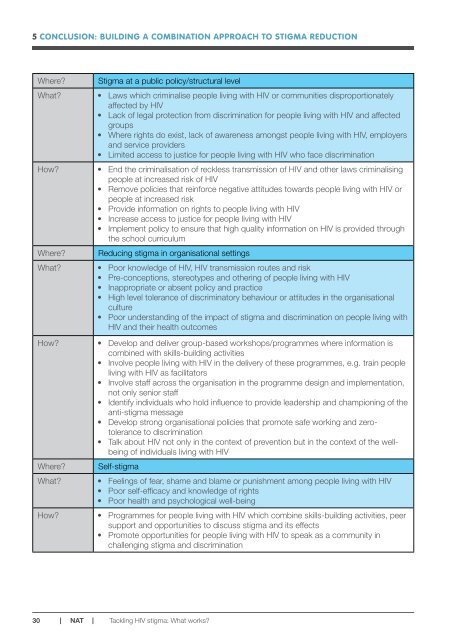Tackling HIV Stigma What works?
Jun_16_Tackling_HIV_Stigma
Jun_16_Tackling_HIV_Stigma
You also want an ePaper? Increase the reach of your titles
YUMPU automatically turns print PDFs into web optimized ePapers that Google loves.
5 CONCLUSION: BUILDING A COMBINATION APPROACH TO STIGMA REDUCTION<br />
Where?<br />
<strong>What</strong>?<br />
How?<br />
Where?<br />
<strong>What</strong>?<br />
How?<br />
Where?<br />
<strong>What</strong>?<br />
How?<br />
<strong>Stigma</strong> at a public policy/structural level<br />
• Laws which criminalise people living with <strong>HIV</strong> or communities disproportionately<br />
affected by <strong>HIV</strong><br />
• Lack of legal protection from discrimination for people living with <strong>HIV</strong> and affected<br />
groups<br />
• Where rights do exist, lack of awareness amongst people living with <strong>HIV</strong>, employers<br />
and service providers<br />
• Limited access to justice for people living with <strong>HIV</strong> who face discrimination<br />
• End the criminalisation of reckless transmission of <strong>HIV</strong> and other laws criminalising<br />
people at increased risk of <strong>HIV</strong><br />
• Remove policies that reinforce negative attitudes towards people living with <strong>HIV</strong> or<br />
people at increased risk<br />
• Provide information on rights to people living with <strong>HIV</strong><br />
• Increase access to justice for people living with <strong>HIV</strong><br />
• Implement policy to ensure that high quality information on <strong>HIV</strong> is provided through<br />
the school curriculum<br />
Reducing stigma in organisational settings<br />
• Poor knowledge of <strong>HIV</strong>, <strong>HIV</strong> transmission routes and risk<br />
• Pre-conceptions, stereotypes and othering of people living with <strong>HIV</strong><br />
• Inappropriate or absent policy and practice<br />
• High level tolerance of discriminatory behaviour or attitudes in the organisational<br />
culture<br />
• Poor understanding of the impact of stigma and discrimination on people living with<br />
<strong>HIV</strong> and their health outcomes<br />
• Develop and deliver group-based <strong>works</strong>hops/programmes where information is<br />
combined with skills-building activities<br />
• Involve people living with <strong>HIV</strong> in the delivery of these programmes, e.g. train people<br />
living with <strong>HIV</strong> as facilitators<br />
• Involve staff across the organisation in the programme design and implementation,<br />
not only senior staff<br />
• Identify individuals who hold influence to provide leadership and championing of the<br />
anti-stigma message<br />
• Develop strong organisational policies that promote safe working and zerotolerance<br />
to discrimination<br />
• Talk about <strong>HIV</strong> not only in the context of prevention but in the context of the wellbeing<br />
of individuals living with <strong>HIV</strong><br />
Self-stigma<br />
• Feelings of fear, shame and blame or punishment among people living with <strong>HIV</strong><br />
• Poor self-efficacy and knowledge of rights<br />
• Poor health and psychological well-being<br />
• Programmes for people living with <strong>HIV</strong> which combine skills-building activities, peer<br />
support and opportunities to discuss stigma and its effects<br />
• Promote opportunities for people living with <strong>HIV</strong> to speak as a community in<br />
challenging stigma and discrimination<br />
30 NAT<br />
<strong>Tackling</strong> <strong>HIV</strong> stigma: <strong>What</strong> <strong>works</strong>?


